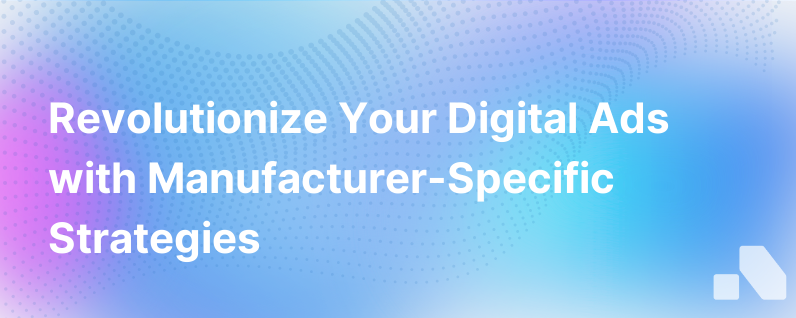
In today's industrial landscape, digital transformation is critical to maintaining a competitive advantage. Manufacturers, traditonally slower in adopting online marketing techniques, are starting to recognize the ROI potential through digital advertising campaigns. However, many still struggle to optimize ad performance, leading to wasted ad spend and missed opportunities to connect with potential customers.
Manufacturers can significantly improve their digital ad campaign performance by adopting a methodical and data-driven approach. Here are the strategies manufacturers should employ to ensure their digital advertising efforts are not just seen, but are also effective.
1. Understand Your Audience Inside and Out
Manufacturers often have a well-defined niche market, but they sometimes fail to leverage this in digital campaigns. Understanding the specific needs, pain points, and online behavior of your target audience is foundational. Use market research, customer interviews, and digital tools to create detailed buyer personas for precise targeting.
For instance, a manufacturer specializing in aerospace parts should know which social platforms their buyers frequent, understand the industry jargon they respond to, and know the time of year when budget decisions are made. This insight will inform when, where, and how you communicate through ads.
2. Deploy Account-Based Marketing (ABM)
With ABM, you can create highly targeted ad campaigns that speak directly to key accounts. ABM focuses on specific companies or decision-makers instead of broad market segments. For manufacturers, this could mean targeting purchasing managers at major industry players or influential engineers within a specific field. Tailor content and messaging that addresses their unique business needs and challenges effectively, which can dramatically improve engagement and conversion rates.
3. Optimize for Search Engines
Search engine marketing (SEM) should be an integral part of your strategy. Most B2B buyers start their purchasing process with a Google search. To capitalize on this, manufacturers need to create ad content optimized with relevant keywords.
Additionally, consider the intent behind the searches. High-purchase-intent keywords, though with lower search volumes, can often lead to higher conversion rates than broader keywords. For instance, optimizing for "high-pressure hydraulic gear pumps" rather than just "hydraulic pumps" can attract buyers that are further down the purchase funnel.
4. Leverage High-quality Visual Content
As a manufacturer, your product's design and functionality are central selling points. High-quality images, interactive 3D models, and videos can showcase your products in action and differentiate your brand. Visual content is more engaging and can significantly increase click-through rates (CTRs). Investing in professional product photography or 3D rendering software is often well worth it.
5. Utilize Retargeting Campaigns
Only a small percentage of first-time visitors to your website will convert into leads or sales. Retargeting campaigns allow you to show ads to individuals who have already shown interest in your company by visiting your site or engaging with your content. Using retargeting strategically can improve ad relevance and conversion rates.
6. A/B Testing and Analytics
Regular A/B testing of ad copy, visuals, calls to action (CTAs), and landing pages can reveal what resonates best with your audience. Paired with analytical tools, you can track performance metrics like CTRs, conversion rates, and cost per acquisition to determine what works and where to allocate resources.
For example, running two variations of a Facebook ad with different images or headlines to the same audience can show which element gets more traction, allowing you to optimize future campaigns.
7. Incorporate Programmatic Advertising
Programmatic advertising automates the buying and selling of online advertisements, targeting specific audiences using AI and real-time bidding. For manufacturers, programmatic ads can place your product in front of the right buyer at the right time across different platforms and devices, maximizing exposure while keeping costs in check.
8. Enhance Mobile Responsiveness
It's crucial to ensure that your ads, landing pages, and any accompanying content are mobile-friendly since decision-makers often research products on their phones or tablets. Mobile responsiveness can directly impact ad engagement and conversion rates.
9. Make Use of Professional Networks
Professional networks like LinkedIn can serve as powerful platforms for manufacturers to run digital ad campaigns. Sponsored content, InMail ads, and dynamic ads can provide tailored content to specific professionals based on job title, function, industry, or even by company.
10. Foster Thought Leadership and Educate Your Audience
Create content that positions your brand as an expert in your industry. Thought leadership ads that educate the customers about trends, challenges, and solutions can demonstrate your firm's industry expertise and insights. It builds trust, which is essential in the long B2B sales cycles typical for manufacturing.
11. Embrace Customer Feedback and Testimonials
Incorporate customer testimonials, reviews, and case studies into your ads to offer social proof of your products’ effectiveness and quality. Potential buyers put significant stock in the experiences of their peers, so showcasing these elements in your campaigns can improve credibility and trust.
Conclusion
Digital advertising for manufacturers is more than creating online ads. It's about speaking the language of your customers, being seen where they are looking, showcasing your solutions in compelling ways, and consistently refining your approach through data analysis. By assessing and integrating these strategies, manufacturers can not only improve their digital ad performance but can also drive more significant business outcomes and ROI.
In an industry that's increasingly competitive and digitized, falling behind is not an option. Manufacturers must embrace these digital marketing strategies to ensure their products and solutions are visible to the right audience at the right time. The impact on digital ad campaign performance can be dramatic, leading to more robust pipelines, increased market share, and higher revenues.